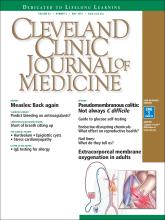ABSTRACT
Although Clostridium difficile infection is the cause of most cases of pseudomembranous colitis, clinicians should consider less common causes, especially if pseudomembranes are seen on endoscopy but testing remains negative for C difficile or if presumed C difficile infection does not respond to treatment. Histologic review of colonic mucosal biopsy specimens can provide clues to the underlying cause.
Footnotes
Nathalie H. Urrunaga, MD, MS, was supported by Grant Number 5 T32 DK067872-07 from the National Institutes of Health (NIH) National Institute of Diabetes and Digestive and Kidney Disease (NIDDK). This document was also supported by the Intramural Research Program of the NIDDK, NIH.
- Copyright © 2016 The Cleveland Clinic Foundation. All Rights Reserved.
- Derek M. Tang, MD⇑
- Digestive Diseases Branch, National Institut of Diabetes and Digestive and Kidney Diseases, National Institutes of Health, Bethesda, MD
- ADDRESS:
Derek M. Tang, MD, Digestive Diseases Branch, National Institute of Diabetes and Digestive and Kidney Diseases, National Institutes of Health, 10 Center Drive, Building 10, 5NW-2740, Bethesda, MD 20892; tangdm{at}mail
- Nathalie H. Urrunaga, MD, MS
- Erik C. Von Rosenvinge, MD
ABSTRACT
Although Clostridium difficile infection is the cause of most cases of pseudomembranous colitis, clinicians should consider less common causes, especially if pseudomembranes are seen on endoscopy but testing remains negative for C difficile or if presumed C difficile infection does not respond to treatment. Histologic review of colonic mucosal biopsy specimens can provide clues to the underlying cause.
Footnotes
Nathalie H. Urrunaga, MD, MS, was supported by Grant Number 5 T32 DK067872-07 from the National Institutes of Health (NIH) National Institute of Diabetes and Digestive and Kidney Disease (NIDDK). This document was also supported by the Intramural Research Program of the NIDDK, NIH.
- Copyright © 2016 The Cleveland Clinic Foundation. All Rights Reserved.






